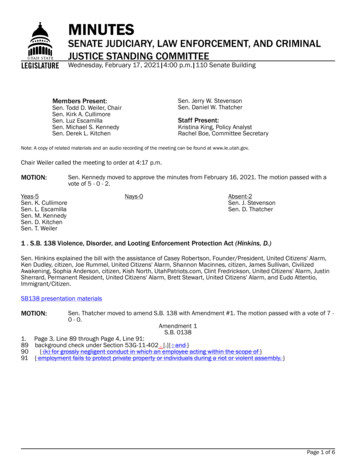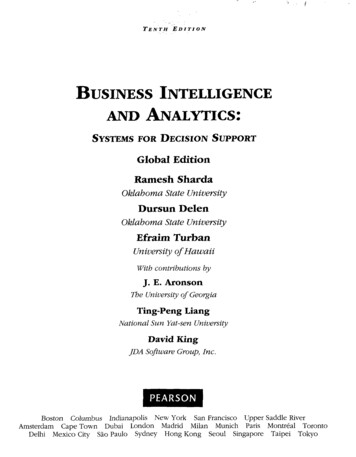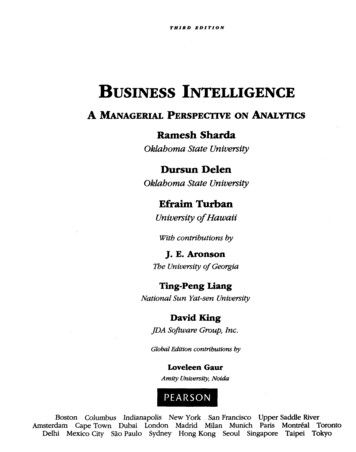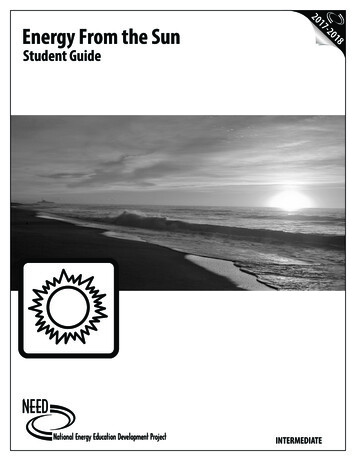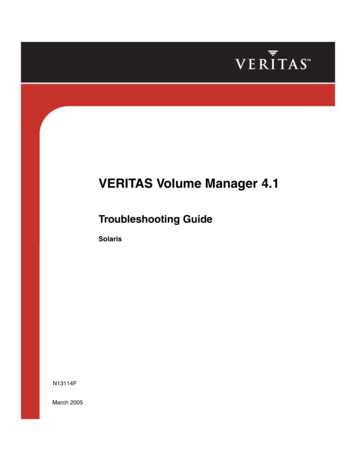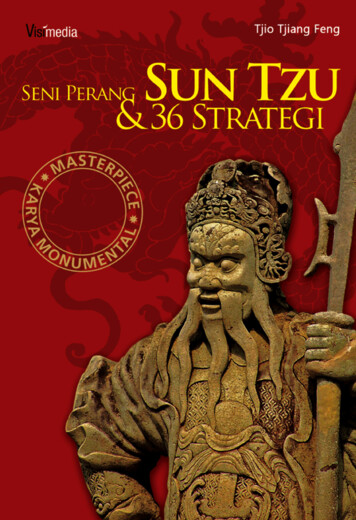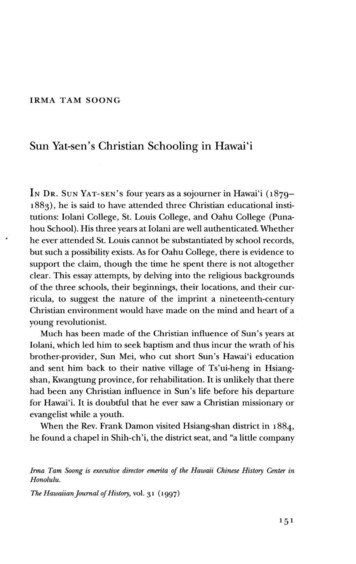
Transcription
IRMA TAM SOONGSun Yat-sen's Christian Schooling in Hawai'ifour years as a sojourner in Hawai'i (1879—1883), he is said to have attended three Christian educational institutions: Iolani College, St. Louis College, and Oahu College (Punahou School). His three years at Iolani are well authenticated. Whetherhe ever attended St. Louis cannot be substantiated by school records,but such a possibility exists. As for Oahu College, there is evidence tosupport the claim, though the time he spent there is not altogetherclear. This essay attempts, by delving into the religious backgroundsof the three schools, their beginnings, their locations, and their curricula, to suggest the nature of the imprint a nineteenth-centuryChristian environment would have made on the mind and heart of ayoung revolutionist.Much has been made of the Christian influence of Sun's years atIolani, which led him to seek baptism and thus incur the wrath of hisbrother-provider, Sun Mei, who cut short Sun's Hawai'i educationand sent him back to their native village of Ts'ui-heng in Hsiangshan, Kwangtung province, for rehabilitation. It is unlikely that therehad been any Christian influence in Sun's life before his departurefor Hawai'i. It is doubtful that he ever saw a Christian missionary orevangelist while a youth.When the Rev. Frank Damon visited Hsiang-shan district in 1884,he found a chapel in Shih-ch'i, the district seat, and "a little companyI N DR. SUN YAT-SEN'SIrma Tarn Soong is executive director emerita of the Hawaii Chinese History Center inHonolulu.The Hawaiian Journal of History, vol. 31 (1997)
152THE HAWAIIAN JOURNAL OF HISTORYof native Christians, under the charge of the English Church Mission."1 As far as he knew, it was "the only Christian Station in all thispopulous region."Sun probably first heard of Christianity through the tales of theTaiping Rebellion (1850-1864) recounted to him by a veteran whohad returned from the wars. Sun was entranced by his accounts,which stirred his imagination as the old classical rote studies heabhorred could not. This first introduction to Christianity was a powerful stimulus for continued revolution, and when he was propelledinto a Christian environment in Hawai'i, his desire to learn about thereligion was satisfied in four intensive years of study in Christianschools.In his account of the Taiping Rebellion, Jen Yu-wen wrote, "It isone of the ironies of history that the very year the Manchus finallyextinguished the greatest eruption of revolutionary nationalism during their reign the seed of a new nationalist movement emerged withthe birth on November 12, 1866 of its future leader, Dr. Sun Yatsen." 2 Jen found it "probably more than coincidence" that HungHsiu-ch'uan, the Taiping leader, and Sun Yat-sen, a revolutionaryleader of modern China, were both Christians. 3 Jen emphasizedHung's role in Sun's revolutionary zeal in his assessment of the historical relationship between the two movements:Our expanding grasp of the aspirations and accomplishments of theTaiping Revolutionary Movement has brought ever more light to itsevolutionary relationship with the National Revolution and heightened our perception of direct historical links. Perhaps the most symbolic instance of this continuity occurred at the transfer of power onJanuary 1, 1912 which ended 267 years of Manchu rule. The abdication of Emperor P'u-i (Hsiian-t'ung) was accepted for the newRepublic of China by Provisional President Sun Yat-sen, who had as aboy cherished the nickname "Hung Hsiu-ch'uan the Second."4In Hawai'i's Christian schools Sun was to learn why Hung mandated"strict observance of the Ten Commandments and attendance atdaily worship" of the Taiping Army.5 "To the end of their lives HungHsiu-ch'uan and his fellow leaders held fast to their Christian faith."6Sun too would, despite all odds, cling to his faith to the very end.
SUN YAT-SEN S CHRISTIAN SCHOOLING IN HAWAII153In 1879 when Sun boarded the Grannoch in Hong Kong for hisvoyage to the Sandalwood Mountains, as the Chinese called Hawai'i,he was impressed by the wonder of a mechanically propelled ship ofmassive proportions and the superiority of the foreigner in thatrespect, but he was at the same time appalled at the simple burial atsea of one of the English sailors. Instead of the elaborate ceremonydue to the dead and necessary to the fortunes of the family, the lawsof feng-shui (geomancy) and other practices were disregarded. Onlythe tolling of a bell and the reading of a book by the ship's captainpreceded the lowering of the flag-draped casket into the waters andthe departure of the deceased into the next world.7 Though he didnot know it at the time, that book was the Book of Common Prayer,which he himself would be using in his Sunday services in Honolulu.Working with his brother Sun Mei in the latter's plantation andstore acquainted him with the goals of most of the Chinese immigrants—to make a living and, if possible, to acquire enough goldpieces to retire to their native villages rich and crowned with respect.Quick to learn conversational Hawaiian, many married or cohabitedwith native women and adjusted to a unique environment where aHawaiian king ruled, flanked by American and European advisers.Few of his compatriots were literate in their own language. Thoserare ones who could speak and read English were high-ranking interpreters to whom the non-English speakers appealed when communication skills were needed.Sun Mei could see that if he were to rise in the financial world, hewould have to have access to knowledge of the system of law that theAmericans had managed to establish in the Hawaiian kingdom. Thebetter educated in the English language his assistant was, the fasterhe would be able to transact his business dealings.EDUCATIONAL OPPORTUNITIES IN HAWAI'IIn 1879 education in the Hawaiian language, but not in English, wasalmost universal. Missionaries of the American Board of Commissioners for Foreign Missions (ABCFM) had arrived in 1820 and byJanuary of 1822 had worked out an alphabet and orthography of theHawaiian language to use in spreading the gospel through the writ-
154THE HAWAIIAN JOURNAL OF HISTORYten word.8 In less than twenty years the first public schools for theHawaiians had been established, and by 1840 the government hadassumed responsibility for teachers' wages and the maintenance ofbuildings. In 1849 Lahainaluna Seminary, a high school on Maui,was founded to train young native Hawaiians for the ministry. Thechief reading text in the schools was the Bible, which had been translated from the original Greek or Hebrew.9The common school system, though somewhat shaky, was by theearly 1830s serving fifty thousand students, most of them adults,enrolled in about eleven hundred schools.10 Four of every ten Hawaiians were learning to read Christian textbooks in the Hawaiian language. In 1840, "the high tide for the Sandwich Islands Mission,10,000 newcomers partook of baptism and communion."11The task of Christianizing the Hawaiian nation and educating itsroyalty in the intricacies of government organization and administration lay mainly on the shoulders of the American missionaries andother foreigners upon whom the Hawaiian rulers relied. In education, both government and religious affiliations did their part in itsamazing progress.12 In 1840 the kingdom had its first written constitution. In 1841 the Congregationalists (ABCFM missionaries) openedPunahou School to provide a secondary college-preparatory education for their own children. In 1846 the Department of PublicInstruction was established with William Richards as its first ministerof instruction. In 1855 Punahou was opened to students of Hawaiianblood. In 1859 Sacred Hearts Academy, a Catholic school, wasfounded for girls. In 1862 Bishop Staley arrived to establish the firstAnglican schools. In 1867 St. Andrew's Priory, an Anglican schoolfor girls, was founded. In 1872 Bishop Willis arrived and foundedIolani College, another Anglican institution.By 1879 there were not only public and private schools but alsoEnglish classes for Chinese adults. One near Chinatown was run bythe Rev. Samuel C. Damon at his Bethel Mission.13 But Sun wouldnot want just to go to classes in English when his brother could affordthe best Western education that money could provide.While there were scattered small private schools throughout theIslands, only two of significance existed in Honolulu. The most prestigious was Punahou, by then named Oahu College. It was situated
SUN YAT-SEN S CHRISTIAN SCHOOLING IN HAWAII155about two miles from Chinatown on a hillside below Manoa Valley.Most of the students were boarders from the Neighbor Islands.14 Theschool's reputation for high standards was so forbidding that noimmigrant boy without a good command of English would dare hopeto be admitted. Principally because he would not qualify, Sun did notgo to Oahu College in 1879.The only other private school of repute in Honolulu was Iolani,which was situated less than a mile above Chinatown on Bates Streetin Nu'uanu. It was a small boarding school established by Anglicansfor Hawaiian boys and was open to Chinese students.Why was Sun Mei, with his intensely ethnocentric pride, open tosending his brother to a Christian school? Was it not run by "whitedevils," who were considered barbarians by the Chinese? The probable answer is that his Chinese respect for scholarship and for its usefulness, no matter what the cost, overcame deep-seated reservationsabout the wisdom of allowing an impressionable youth to learnunder the tutelage of zealous, proselytizing missionaries. Most important of all, it was extremely practical to learn the English language,for skill in its use would open opportunities for rising economicallyin a society dominated by British and American residents.Sun Mei no doubt had the Chinese "self-styled cultural superiority" that underlay China's rigid resistance to change.15 Still, Christianideals of reverence toward divinity, of universal brotherhood, of compassion, and of exemplary moral conduct were compatible with thebest of his own. A Christian school would keep young Sun understrict discipline. He would learn right from wrong and grow up to bea virtuous adult, not easily tempted by the vices common to mankind.Surely the old Chinese customs and traditions would be observed. Ifhe had the slightest apprehension that his brother would succumb tothe appeal of a foreign religion and on graduation seek to be baptized, he dismissed it. Besides, in the Islands Chinese Christians weredefinitely in the minority. In 1881 only five hundred of the fourteenthousand Chinese were Christians.16 And most of these were Hakkas,in contrast to the Puntis, who were on the whole non-Christian. SunMei was a Punti, one of a multitude of immigrants from Chung-shandistrict and other areas of Kwangtung who felt themselves superior tothe Hakkas.
156THE HAWAIIAN JOURNAL OF HISTORYThe cleavage between the Hakkas and Puntis had arisen from conflicts in the old country. The Puntis were the natives of Kwangtungprovince, a mixed race of the original tribes and people from northChina who had migrated to central China. During the Han dynasty(206 B.C.-A.D. 228) they had migrated south and therefore considered themselves the natives. The Hakkas migrated to Kwangtungfrom northern and central China between 1250 and 1700.17In general, the immigrants from Sun's Chung-shan district cameto Honolulu unconverted and remained true to the old practices.Later many were converted by ABCFM missionaries and Chinese pastors and evangelists who could speak Cantonese, the prestigious version of the Punti dialect.18 Most of the Hakka Christians, on theother hand, had come from areas near Hong Kong and towns in thecoastal area. Their parents had been converted by Basel and Berlinmissionaries, who first came to Kwangtung in 1847.19The Chinese churches in Hawai'i can be said to be the fruits of theearly labor of the Lutheran missions, mainly the Basel Mission Society, for many of the pastors in the years that followed were trained inthe seminary at Lilong. The first Basel-trained pastor to serve inHawai'i arrived in 1872. He was sent to Kohala to work for the Congregational Church under the direction of the Rev. Elias Bond. KongTet Yin had worked in Australia and was therefore a pastor at onetime or another of three Christian denominations—the Lutheran,the Anglican, and the Congregationalist.20In Sun Yat-sen's Iolani days, the Congregationalist Hawaii Evangelical Association (HEA) was continuing to welcome Chinese Christiansof Lutheran backgrounds and to evangelize among the sojourningnon-Christians. By 1877 young Christians had formed the ChineseYMCA (later the Chinese Christian Association of Hawai'i) and hadbeen granted a charter by the Hawaiian government.21 In 1879, theyear Sun entered Iolani, thirty-six members of the Chinese ChristianChurch received a charter of incorporation. In 1881 the church,with more than one hundred members, dedicated a two-story building of its own on Fort Street near Beretania.22 In that same year, theRev. Francis M. Damon, who was to play a supporting role in Sun'sconflict with Sun Mei on his second trip to Hawai'i in 1885, becamesuperintendent of the HEA'S work among the Chinese.23 Serving on
SUN YAT-SEN S CHRISTIAN SCHOOLING IN HAWAI I157the church's board were self-made Chinese such as Goo Kim Fui andearnest Caucasians who helped to "manage the property, raise fundsfor repair and improvement, and provide for an expansion of thework." Represented among the latter were Charles M. Hyde andmembers of the Davies, Atherton, Damon, and Waterhouse families.24The cordial relations of the Chinese with the "white devils" wereevident in the help given them in raising the funds to build the Chinese Christian Church of Honolulu. The Caucasians even lent thechurch parlors of their older Fort Street Church for the bazaar whilethe women brightened indoors and outdoors with lanterns, brocades,tapestry, and other glittering attractions. Royalty too graced the affairwith their presence. Likelike, sister of Kalakaua, who was away on hisworld tour, represented the king. Also in attendance were clergymenand government dignitaries and their families.25Surely Sun Yat-sen must have heard about this great event in avicinity familiar to him. These white people were not like the oneswho started the Opium Wars and pointed their guns at China's portsto open the way to further exploitation. These were Christians, a different breed of white men he had become acquainted with at Iolani.Furthermore, while prejudice against the Chinese took various forms,both legal and vocal, the HE A persisted in believing that "Christianbrotherhood held the best, perhaps the only answer"26 to the vexingquestions of racial conflicts. To have white people cooperate so amicably with his own countrymen and believe in their goodness musthave nurtured a faith that was to sustain Sun in the years when noEuropean Christian nation would support his cause.With such a history of progress, one would suppose that the HE Awould have opened a boarding or day English language school withan academic curriculum for Chinese boys. That was not available,however, and English classes for immigrants in the church did notmeet Sun's yearning for the best Western education possible.IOLANI, AN ANGLICAN SCHOOLIolani, then, was the school for Sun. It was Anglican, a mission schoolunder the auspices of the Church of England, from which the Congregationalists (Calvinist Protestants) had fled to settle in New
158THE HAWAIIAN JOURNAL OF HISTORYEngland in America's early history. Anglicans were far less puritanical in their religious and secular beliefs. Their beginnings in Honolulu were not so much to evangelize as to satisfy King KamehamehaIV's dislike of the American Mission where he was educated and toestablish a church patterned after the English.27 While in London hehad met royalty and found the English hierarchical system and splendor a model for himself. Furthermore, he loved the ritual of theAnglican service with its chanting, its liturgy, and the rich, elegantrobes of the clergy, all set in beautiful cathedrals with stained-glasswindows.In 1861 the king offered to donate a site for an Anglican churchin Honolulu and 1,000 a year for a clergyman's services. With theaid of several prominent English churchmen, Manley Hopkins, theHawai'i consul at London, formed a missionary bishopric with theRev. Thomas Nettleship Staley as its head. Bishop Staley arrived on11 October 1862. Queen Emma was baptized two weeks later, andthe royal couple were confirmed as members of the newly charteredHawaiian Reformed Catholic Church. In December the high chiefKalakaua was confirmed. With the addition of key Anglican leadersin the kingdom and Staley's position in the Privy Council, the political power of the American missionaries was visibly threatened.28Kamehameha IV himself translated the Book of Common Prayer intoHawaiian. Staley, to the disgust and dismay of the puritanical Congregationalists, encouraged the revival of hula dancing and chanting atthe funerals of chiefs. The theatricality, the chanted liturgy, the richvestments of the clergy, as well as pictures on the walls of the churchsatisfied the native Hawaiians' inhibited desire for celebration andpageantry.29When Kamehameha IV died on 30 November 1863, at the age oftwenty-nine, and Princess Victoria Kamamalu died in 1866, the funerals were elaborate and loud with the laments of natives to please themost traditional Hawaiian.30 Bishop Staley, however, was not able toplease the white members of his congregation in matters of doctrineand practice. In May 1870 he resigned. The clergy in England, hissuperiors, considered turning the mission over to the American Episcopalians (Anglicans before the American Revolution of 1776).Queen Emma fought the move and won.31
SUN YAT-SEN'S CHRISTIAN SCHOOLING IN HAWAl'l159It was Bishop Staley who opened church schools for both boys andgirls at the request of King Kamehameha IV and Queen Emma totrain young Hawaiians for leadership roles in the government. Theywanted the schools to provide their young ones withthe highest English culture and religious training from childhood;otherwise they cannot take their proper share in their own government and uphold the ideals therein as the king desires. At presentthere are no Hawaiians occupying high office in the government ofthe country.32Both schools were conducted in English. The king contributed 4,000 for the erection of a building for the Female Industrial Boarding School at Kaalaa at the entrance of Pauoa Valley. Under the patronage of Queen Emma, the school was advertised in the Polynesianon 8 November 1862 as a family boarding and industrial school withemphasis on the domestic arts and with French, German, music,dancing, and embroidery offered at extra cost. The cost was 25 aterm for girls under twelve. Mrs. George Mason was its head.The boys' school, St. Alban's College, was opened on 12 January1863 under the charge of Father George Mason. It began as a dayschool, possibly at the same site. The king donated 1,100 for itsbuildings.33 Its offerings included "Latin, Greek, Euclid, algebra, andthe usual branches of an English education, at the tuition rate oftwelve dollars a quarter." In 1863 it had twenty boarding and severalday students and was doing so well that a schoolmaster from Englandwas sent for to assist Father Mason.In that same year Mason was sent to Lahaina, Maui, to build up aschool named Luaehu, started in 1863 by the Rev. William R. Scott,who had to return to England because of failing health. Iolani Schoolrecognizes the establishment of Luaehu School by Scott as its founding.34 Luaehu School was popularly referred to as the Rev. GeorgeMason's School.35 At St. Alban's in Honolulu, changes were takingplace in the meantime. In 1864 Edmund Ibbotson, who had beenin charge of the Cathedral Grammar School, a charity school for"poor, outcast Hawaiian boys," became the head of St. Alban's. Heremained in that capacity until 1866, when Mr. Turner succeededhim. St. Alban's must have encountered difficulties, for in 1868 it
l6oTHE HAWAIIAN JOURNAL OF HISTORYhad only sixteen scholars while Luaehu had eighteen. In March of1868 the stronger Luaehu was merged with St. Alban's.36In 1872 Bishop Alfred Willis arrived to take charge of the mission,which was renamed the Anglican Church of Hawai'i. (It was not until1902 that the American Episcopal Church assumed jurisdiction overthe Anglican Church in Hawai'i.) He stayed thirty years and was thebishop who established Iolani School.Upon his arrival, Bishop Willis promptly purchased land on BatesStreet in Nu'uanu Valley for a school for Hawaiian and part-Hawaiianboys. He considered it a continuation of the combined schools atPauoa and named it Iolani College, a name already referred to St.Alban's by King Kamehameha V.37 Bishop S. Harrington Littell givesthis version of the origin: The name Iolani was applied to Kamehameha II, who, according to Kamehameha IV, in the preface of histranslation of the Prayerbook into Hawaiian,went to England to remind the King of the promise of Vancouver tosend teachers of the true God. Iolani was the name sometimes appliedto the highest royal person. It may have been connected with theSupreme Being who, Polynesians believed, was above all gods andchiefs. The Maoris called this Supreme Being Io, and lani meansheaven or heavenly. Old Hawaiians have told the writer that the meaning the word conveys to them is one soaring above all others, for themeaning of Io in Hawaiian is a specie of hawk.38St. Alban's was intended for haole (white) boys, while Iolani Collegewas intended for Hawaiians and part-Hawaiians. In 1876 St. Alban'shad thirty-four boys and one girl, while Iolani had thirty-five students.In 1887 St. Alban's closed.39 In 1878 Iolani had fifty-eight boys. WithBishop Willis as the headmaster, assisted by several instructors fromEngland, this private school grew more slowly, as it was sufferingfrom dissension within the church and competition with Oahu College. To enlarge its enrollment, it admitted Chinese boys, amongthem Sun Yat-sen, all of whom had little or no previous schooling inthe English language.When Sun entered Iolani, then known popularly as Bishop'sSchool, in September of 1879 he was one often Chinese boys.40 Thefirst two who registered were Tong Phong, son of Tong Ching, one of
SUN YAT-SEN'S C H R I S T I A N S C H O O L I N G IN H A W A l ' ll6lfour partners of the wealthy Sing Chong Company, and Lee Butt,brother-in-law of Chun Afong, the most notable figure in the earlyhistory of the Chinese in Hawai'i. Two weeks after school opened,Sun Tai Cheong (Ti-hsiang), as Sun was familiarly known to hisschoolmates, was enrolled under the name Tai Chu.41 Already therewas Chung Kun Ai, who had registered by himself. Admitted laterwere John Akana, Chun Mun Him, Lee Kam Lung, Leong Neng,Leong Bun, and Look Lee.Ai described the difficult adjustment for one who understood neither English nor Hawaiian well. They were hard-pressed to keep up.Mr. Merrill, their spelling teacher, would spank them on the palmthree times with his ivory ruler when they missed three words. Thepunishment was more severe with five mistakes or more. In the studyhall at night, no one dared to make a noise. Once in bed, no onespoke. Bishop Willis visited the dormitory at unexpected hours of thenight and paternally covered the boys with a blanket if it had beenkicked off.«The six boarders had their fun, swimming at Kapena Falls, stayingthere two or three hours, eating mangos fallen from the propertynext door, and enjoying food sent by doting parents. They hadchores to do too, such as planting vegetables and lugging water forindoor use.A more detailed description of school life on the Bates Street campus between 1872 and 1902 is given in the September 1912 issue ofthe Hawaiian Church Chronicle:A day at Iolani began at 5:30 o'clock A.M. with the ringing of a bell, tothis duty a boy was assigned for a week. After an early rising the boyswalked up to Alekoki or Kapena for a morning plunge. This was beforewe got water from the government main. At 6:30 the boys were linedup on the verandah of the dormitory and there each name was calledout; afterwards the boys filed into the chapel; then after chapel for halfan hour the boys were detailed to clean up the different places, towhich a number of boys were assigned. Breakfast followed at 7:30. 8:15to 9 A.M. drill was held on Mondays and Fridays, from 8:15 to 9 A.M.singing lessons on Tuesdays and Thursdays; from 9 to 11145 was takenup with our studies. Lunch at 12; school again from 1 till 2; from 3:45till 4 P.M. each day was set aside for manual labor consisting of gar-
162THE HAWAIIAN JOURNAL OF HISTORYdening, working in the printing office, carpenter shop and generalcleaning up of the premises. At 4:15 the bell rang again to discontinuework and go up to Kapena to bathe.We sat down to supper at 5:30, chapel again at 6:30. Then studyfrom 7 till 9, when everyone retired and lights were ordered out by9:20.43Since Iolani was primarily a religious institution, it was natural thatthe religious education of its students was the church's main concern.Daily attendance at morning and evening prayer was a required routine. . . . The Bishop concerned himself with the instruction of hispupils in Christian doctrine. He inculcated in them a critical attitudetoward superstition and idolatry. . . . Every reasonable persuasion wasbrought to bear on the boys to present themselves for baptism.44Ai tells about the bishop's hiring of a young Chinese evangelist,Wong Shek Yen,45 for six dollars a month plus the chance to studyEnglish as a day student, to teach the boarders Bible in the afternoonon the school verandah. However, he evidently bored them to thepoint that he had to give up evangelizing and keep their attention bytelling them Chinese stories instead.All boarders were required to go to church on Sunday.46 The services were held in the procathedral, a temporary wooden structurethat would not be replaced with the present magnificent St. Andrew'sCathedral until 1886. The boys marched from Bates Street downNu'uanu Street to Beretania, turned left to Fort Street, then walkedon to Queen Emma Street, where the procathedral was located. Anearlier service was held in Hawaiian followed by the 11 :oo Englishservice that the boys attended. They sat in assigned pews to the rightof the aisle. After the service, they marched back to Bates Street.Sun was a conscientious student, and upon his graduation on 27July 1882 he was presented the second prize for excellence inEnglish grammar by King Kalakaua himself. The prize was an Englishbook about China. Queen Emma and Princess Lili'uokalani werealso present. 47Sun Yat-sen's three years at Iolani introduced him to Westernlearning. It also "led him to want more western education—morethan that required to assist in his brother's business," according to
SUN YAT-SEN'S CHRISTIAN SCHOOLING IN HAWAl'l163biographer Harold Schiffrin.48 By this time, he was seeking Sun Mei'spermission to become baptized. Sun Mei, of course, being a traditionalist, refused.ST. LOUIS COLLEGE, A CATHOLIC INSTITUTIONTo continue his studies Sun had the choice of two other privateChristian schools. One was St. Louis and the other, Oahu College.Two questions plague the historian. Did Sun actually attend both orjust Oahu College or not even the latter? What evidence is there thathe studied in either?Jen Yu-wen remarked briefly, "Then, he transferred to the St.Louis College (of high standing)," seemingly accepting the fact ofSun's attendance there.49 A more credible statement is found in PaulLinebarger's interviews for his biography of Dr. Sun:After graduation from the Bishop's School with first honors, heattended to the business affairs of his brother for a half year, afterwhich he attended a higher school in Honolulu called St. Louis School.Here he studied for a term, finally pursuing his studies in the HawaiiCollege.50By "Hawaii College" he no doubt meant Oahu College. According toJohn C. H. Wu, "he was permitted in the winter of 1882, to enter St.Louis College in Honolulu, where he studied for a semester."51The whole question as to whether Sun actually matriculated at St.Louis is tied to the question of when he attended Oahu College afterhe left St. Louis, if he did attend St. Louis at all. The beginnings ofSt. Louis College are obscured by a lack of early records. No mentioncan be found of Sun's presence there.As a religion, Catholicism was the target of a series of religiousconflicts that were entangled with political ramifications. The arrivalof the first French missionaries to Honolulu in July of 1827 exacerbated an already volatile political situation.52 They were not welcomeas no one had cleared the way for their presence. They landed without permission and were ordered back on board their ship by Governor Boki, but in his absence they were later left ashore.The Congregationalists were visibly upset by the intrusion of thevery establishment from whose authority the Protestant Revolt had
164THE HAWAIIAN JOURNAL OF HISTORYfreed them. The Catholics were accused of idolatry because of theirstatuary, but Hawaiians—and Chinese too—found no differencebetween one ki'i, or idol, and another, be it heathen or Catholic.53Despite opposition, however, the Catholic Church attracted members. Under the 1849 constitution, which guaranteed freedom of religion, all sides managed to coexist, though not without controversy.The 1840s were good years for both Congregationalists and Catholics. In 1841, the Congregationalists voted funds for the establishment of Oahu College. In 1842 the fifth Kawaiaha'o Church, thepresent edifice, was completed. In 1843 the Catholics built theirbeautiful Our Lady of Peace Cat
Sun Yat-sen's Christian Schooling in Hawai'i IN DR. SUN YAT-SEN'S four years as a sojourner in Hawai'i (1879— 1883), he is said to have attended three Christian educational insti-tutions: Iolani College, St. Louis College, and Oahu College (Puna-hou School).
